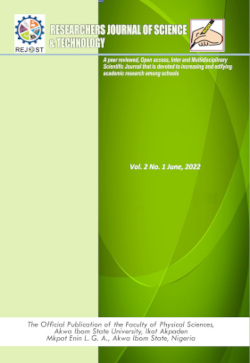Facies Analysis, Rock properties and Depositional Environments of ‘UQ’ Field, Niger Delta, Southern Nigeria
Keywords:
Well Log, Petrophysics, Facies, Depositional Environment, Sequence StratigraphyAbstract
Despite significant hydrocarbon production in the UQ field, the reservoir complexity and heterogeneity have made it challenging to accurately characterize the reservoir properties. Hence, the goal of this research was to conduct a complete facies analysis and rock properties characterization of the UQ field in order to improve reservoir understanding and optimize hydrocarbon production. In this research, petrophysical and facies analyses of the UQ field utilizing well logs were conducted. Porosity, permeability, water saturation, net to gross ratio, and net pay thickness are some of the petrophysical characteristics that were taken into account in this study. Four wells in total were taken into account for the investigation, and four reservoirs were successfully identified. The reservoir sands' depositional facies and environment were distinguished using the gamma ray log. Each well underwent a thorough investigation of its petrophysical properties, and the reservoir thickness, net pay, net-to-gross ratio, porosity, and water saturation were all computed. The reservoirs had good petrophysical characteris-tics, with total gross thicknesses ranging from 218.87 to 584.76 feet and net to gross thicknesses varying from 157 to 414 feet due to shale intercalations. The reservoir's N/G ratio of 81% shows that reservoir sands occupy a larger share of the rock's bulk volume. The reservoirs' average water saturations range from 0.17 to 0.41. In general, it is seen that the porosity values within the wells are declining. The four reservoirs' estimated average porosities were between 0.24 and 0.30. The reservoir sands' impacts on particle size and sorting may be primarily responsible for the porosity values. The gamma ray log's form was used to establish the depositional setting for each reservoir. The majority of the basin floor fans and slope fan systems made up the depositional environment for the reservoirs.
References
Achie, G. (1942). The Electrical Resistivity log as an aid in determining some reservoir characteristics. Transaction of the AIME, 146, 54-62.
Amigun, J. O. (1998). Interpretation of seismic reflection data over Okpoko oil field, Niger Delta. M.Sc thesis, Obafemi Awolowo University, Ile-Ife, 98.
Avboubo, A.A. (1978) Tertiary Lithostratigraphy of Niger Delta. American Association of Petroleum Geologists Bulletin, 62, 295-300.
Baker, H.I. (1992). Advanced Wireline and MWD Procedures Manual. B.H.I. Technical Publications Group.
Bhattacharya, J. P., Walker, R. G. (1992). Deltas. In Facies Succession in river and wave-dominated depositional systems of the Upper Cretaceous Dunvegan Formation, Northwestern Alberta, Bulletin Petrol. Geol., 39, 165 - 191.
Chapman, R. E. (1983). Petroleum Geology: in developments in petroleum science, Amsterdam, Elsevier, 16, 415.
Doust, H, Omatsola E., (1990). Niger Delta, in, Edwards, JD and Santogrossi, PA eds., Divergent/passive Margin Basins. American Assoc. of Petroleum Geologists (AAPG) Memoir 48: 239-248.
Etesin, U., Ite, A. E., Harry, T.A., Bassey, C.E. (2015). Assessment of cadmium and lead distribution in the outcrop rocks of Abakaliki Anticlinorium in the Southern Benue TroughNigeria. Journal of Environment Pollution and Human Health, 3, 62 - 69. DOI: 10.12691/jephh-3-3-2 (U.S.A).
Harry, T.A., Akata, N.I. (2019). Evaluation of Shale Volume and effective porosity from wire line logs in “Watty” Field, Niger Delta, Nigeria. International Journal of Scientific & Engineering Research. 10, (12), 1150 - 1158 (U.S.A).
Harry, T. A., Etuk, S. E., Joseph, I. N., Austin, O. E. (2018). Geomechanical evaluation of reservoirs in the coastal swamp, Niger Delta Region, Nigeria. International Journal of Advanced Geosciences, 6(2), 165-172. Doi10.14419/ijagv6i2.13782 (Amman, Jordan).
Kulke. H. (1995). Regional Petroleum Geology of the world. Part 11, Africa, America, Audtralia and Antarctica, Gebruder Borntraeger, Berlin, 143-172
Selly, R. C. (1970). Ancient Sedimentary Environments. Chapman and Hall, Ltd., London, 237.
Shannon, P. M., Naylor, N. (1989). Sequence stratigraphy and depositional sequence interpretation; A case study of George field, offshore Niger Delta, Nigeria, Petroleum Research, 3, 25-35.
Short, K. C. and Stauble, A. J. (1975). Outline of geology of Niger Delta. AAPG Bulletin. 51(5), 761 - 799.
Okwoli, E., Obiora, D.N., Adewoye. O., Chukudebelu, J. U., Ezema, P. O. (2015). Reservoir characterization and volumetric analysis of “Lona” field, Niger Delta, Using 3-D seismic and well log data. Petroleum & Coal, 57(2) 108-119

Downloads
Published
How to Cite
Issue
Section
License
Copyright (c) 2023 Researchers Journal of Science and Technology

This work is licensed under a Creative Commons Attribution-NonCommercial-NoDerivatives 4.0 International License.




